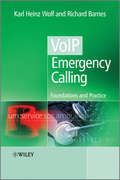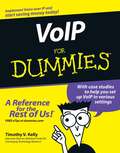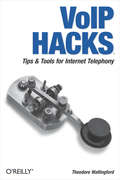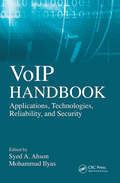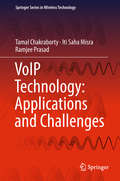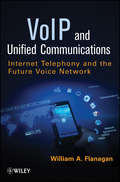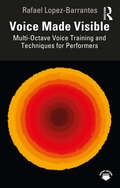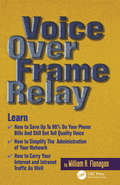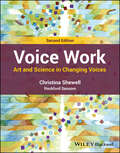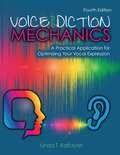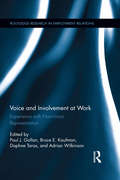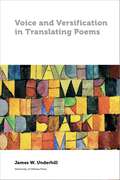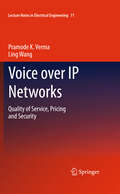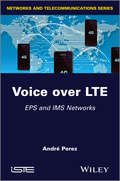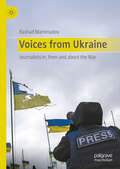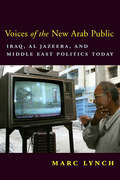- Table View
- List View
Vita contemplativa: Elogi de la inactivitat
by Byung-Chul HanUna poderosa crida a abandonar la vida hiperactiva per recuperar l'equilibri i la riquesa interior. Estem perdent la nostra capacitat de no fer res. La nostra existència és absorbida per l'activitat i, per tant, completament explotada. Atès que només percebem la vida en termes de rendiment, tendim a entendre la inactivitat com un dèficit, una negació o una absència d'activitat quan es tracta, ben al contrari, d'una interessant capacitat independent. Byung-Chul Han indaga en els beneficis, l'esplendor i la màgia de l'ociositat i dissenya una nova forma de vida que inclogui moments contemplatius amb els quals poder afrontar la crisi actual de la nostra societat i frenar la nostra pròpia explotació i la destrucció de la naturalesa.
Vivir en la nube: Adolescencia en tiempos digitales
by Roberto BalaguerRoberto Balaguer nos presenta de manera clara y concisa las problemáticas que surgen en el convulsionado mundo de internet. Ya hemos aceptado que la tecnología está cambiando al mundo de forma acelerada. Como padres, como docentes, e incluso como usuarios, intentamos enfrentar nuestros temores y acompañar a aquellos para quienes somos un referente. Sin embargo, no siempre lo logramos. A través de las páginas de este libro, Roberto Balaguer nos presenta de manera clara y concisa las problemáticas que surgen en este mundo. Además de darnos herramientas para comprender como pararnos en este escenario, nos invita a cuestionar nuestras respuestas políticamente correctas y a reflexionar sobre nuestras decisiones de la vida cotidiana. Cuando la sociedad se conmovió por la aparición del juego en línea llamado Ballena azul, el autor nos planteaba: Inmersos en una cultura de saturación de información, de alta tecnología, es frecuente que ante todos estos cambios busquemos hacer frente a los desafíos que tenemos como padres con más tecnología, pero lo cierto es que eso no siempre funciona. En toda esta temática hay tres palabras, que casualmente empiezan de la misma manera, «con», y que ilustran distintos modos de abordar estas cuestiones: control, confianza, contención.
VoIP Emergency Calling
by Richard Barnes Karl Heinz WolfThis book provides a comprehensive view of the emerging standards for VoIP emergency calling from an International perspectiveIn this book, the authors provide a treatment of the VoIP emergency calling process that is both comprehensive, looking at all aspects of emergency calling, and practical, providing technical details on how such functions can be implemented. In addition, the authors describe the standardization efforts of the Internet Engineering Task Force who are currently working to improve the situation for VoIP emergency calls. The book provides an overview of emergency calling with a particular focus on the ECRIT emergency calling architecture, and discusses considerations related to implementation, deployment, and regulation of next-generation emergency calling. It also takes a look at practical aspects of emergency calling, with a set of exercises to help the reader get familiar with the technologies involved.Key Features:Comprehensive view of emerging standards for VoIP emergency calling from an international perspectivePractical guides for implementing the core of the emergency calling architectureArchitectural, practical, and regulatory perspectivesWritten by experts working on the development of emergency calling architectures and its implementationIncludes an accompanying website with open-source software packages (http://www.voip-sos.net/)This book will be an invaluable resource for product managers and developers, equipment vendors, network operators, emergency service providers, and telecommunications regulators. Industry professionals interested in standards compliance will also find this book of interest.
VoIP For Dummies
by Timothy V. KellyPut your phone system on your computer network and see the savingsSee how to get started with VoIP, how it works, and why it saves you moneyVoIP is techspeak for "voice over Internet protocol," but it could spell "saving big bucks" for your business! Here's where to get the scoop in plain English. Find out how VoIP can save you money, how voice communication travels online, and how to choose the best way to integrate your phone system with your network at home or at the office.Discover how to:Use VoIP for your business or home phone serviceChoose the best network typeSet up VoIP on a wireless networkUnderstand transports and servicesDemonstrate VoIP's advantages to management
VoIP Hacks: Tips & Tools for Internet Telephony
by Theodore WallingfordVoice over Internet Protocol (VoIP) is gaining a lot of attention these days, as more companies and individuals switch from standard telephone service to phone service via the Internet. The reason is simple: A single network to carry voice and data is easier to scale, maintain, and administer. As an added bonus, it's also cheaper, because VoIP is free of the endless government regulations and tariffs imposed upon phone companies.VoIP is simply overflowing with hack potential, and VoIP Hacks is the practical guide from O'Reilly that presents these possibilities to you. It provides dozens of hands-on projects for building a VoIP network, showing you how to tweak and customize a multitude of exciting things to get the job done. Along the way, you'll also learn which standards and practices work best for your particular environment. Among the quick and clever solutions showcased in the book are those for:gauging VoIP readiness on an enterprise networkusing SIP, H.323, and other signaling specificationsproviding low-layer security in a VoIP environmentemploying IP hardphones, analog telephone adapters, and softPBX serversdealing with and avoiding the most common VoIP deployment mistakesIn reality, VoIP Hacks contains only a small subset of VoIP knowledge-enough to serve as an introduction to the world of VoIP and teach you how to use it to save money, be more productive, or just impress your friends. If you love to tinker and optimize, this is the one technology, and the one book, you must investigate.
VoIP Handbook: Applications, Technologies, Reliability, and Security
by Mohammad Ilyas Syed A. AhsonThe number of worldwide VoIP customers is well over 38 million. Thanks to the popularity of inexpensive, high-quality services, it's projected to increase to nearly 250 million within the next three years. The VoIP Handbook: Applications, Technologies, Reliability, and Security captures the state of the art in VoIP technology and serves as the comprehensive reference on this soon-to-be ubiquitous technology. It provides: A step-by-step methodology to evaluate VoIP performance prior to network implementation An invaluable overview of implementation challenges and several VoIP multipoint conference systems Unparalleled coverage of design and engineering issues such VoIP traffic, QoS requirements, and VoIP flow As this promising technology’s popularity increases, new demands for improved quality, reduced cost, and seamless operation will continue to increase. Edited by preeminent wireless communications experts Ahson and Illyas, the VoIP Handbook guides you to successful deployment.
VoIP Technology: Applications and Challenges (Springer Series in Wireless Technology)
by Ramjee Prasad Tamal Chakraborty Iti Saha MisraThis book offers an accessible introduction and practical guide to Voice over Internet Protocol (VoIP) technology, providing readers with the know-how to solve the problems encountered in applying VoIP technology across all types of network. It incorporates the latest research findings and brings readers up to date with the challenges that are faced by researchers developing novel applications of VoIP.The authors discuss the general architecture of VoIP technology, along with its application and relevance in conventional and emerging wireless communication networks, including Wireless Local Area Networks (WLANs), Worldwide Interoperability for Microwave Access (WiMAX), Long Term Evolution (LTE) and Cognitive Radio Networks. The book also includes Quality of service (QoS) studies under dynamic and unpredictable network conditions, which examine the reliability of both legacy systems And the upcoming pervasive computing systems. Further, it explains how the heuristic-based learning algorithms that are used in VoIP communications may help develop today’s technology in the area of autonomous systems.This book is a valuable source of information for academics and researchers, as it provides state-of-theart research in VoIP technology. It is also of interest to network designers, application architects, and service providers looking for a coherent understanding of VoIP across a wide range of devices, network applications and user categories.
VoIP and Unified Communications: Internet Telephony and the Future Voice Network
by William A. FlanaganTranslates technical jargon into practical business communications solutions This book takes readers from traditional voice, fax, video, and data services delivered via separate platforms to a single, unified platform delivering all of these services seamlessly via the Internet. With its clear, jargon-free explanations, the author enables all readers to better understand and assess the growing number of voice over Internet protocol (VoIP) and unified communications (UC) products and services that are available for businesses. VoIP and Unified Communications is based on the author's careful review and synthesis of more than 7,000 pages of published standards as well as a broad range of datasheets, websites, white papers, and webinars. It begins with an introduction to IP technology and then covers such topics as: Packet transmission and switching VoIP signaling and call processing How VoIP and UC are defining the future Interconnections with global services Network management for VoIP and UC This book features a complete chapter dedicated to cost analyses and payback calculations, enabling readers to accurately determine the short- and long-term financial impact of migrating to various VoIP and UC products and services. There's also a chapter detailing major IP systems hardware and software. Throughout the book, diagrams illustrate how various VoIP and UC components and systems work. In addition, the author highlights potential problems and threats to UC services, steering readers away from common pitfalls. Concise and to the point, this text enables readers—from novices to experienced engineers and technical managers—to understand how VoIP and UC really work so that everyone can confidently deal with network engineers, data center gurus, and top management.
Voice
by Scott DamianFor thirty-three years, Scott Damian fought an arduous battle for freedom from stuttering. He was imprisoned by the terror of being unable to utter a single word, until he transformed into a highly successful actor and writer. Scott speaks to the heart and soul of a stutterer, and addresses healing, help, and hope for the millions who are similarly afflicted.
Voice Lessons for Parents: What to Say, How to Say it, and When to Listen
by Wendy MogelRenowned speaker, parenting expert, and New York Times bestselling author Dr. Wendy Mogel offers an essential guide to the new art of talking to children, showing how a change in tone and demeanor can transform the relationship between parent and child.Most parents are perfectly fine communicators—unless they’re talking to their children. Then, too often, their pitch rises and they come across as pleading, indignant, wounded, outraged. In tone and body language they signal, I can’t handle it when you act like a child. Dr. Wendy Mogel saw this pattern time and again in her clinical practice. In response, she developed a remarkably effective series of “voice lessons,” which she shared with parents who were struggling with their kids. The results were immediate: a shift in vocal style led to children who were calmer, listened more attentively, and communicated with more warmth, respect, and sincerity. In Voice Lessons for Parents, Mogel elaborates on her novel clinical approach, revealing how each age and stage of a child’s life brings new opportunities to connect through language. Drawing from sources as diverse as neuroscience, fairy tales, and anthropology, Mogel offers specific guidance for talking to children across the expanse of childhood and adolescence. She also explains the best ways to talk about your child to partners, exes, and grandparents, as well as to teachers, coaches, and caretakers. Throughout the book, Mogel addresses an obstacle that bedevils even the most seasoned and confident parent: the distraction of digital devices, how they impact our connection with our families, and what we can do about it. Mogel’s now classic book, The Blessing of a Skinned Knee, is a beloved resource for a generation of parents. Voice Lessons for Parents brings her unique brand of practical wisdom to harried parents eager to deepen their relationships with their kids. “Children will lead you on an incredible journey,” writes Mogel, “if they trust you, if you take the time, and if you’re willing to follow.”
Voice Made Visible: Multi-Octave Voice Training and Techniques for Performers
by Rafael Lopez-BarrantesVoice Made Visible is an exploration of voice training and performance practice based on the use and application of Multi-Octave Vocal Range techniques. "Multi-Octave" is understood as the arsenal of sounds that exists uniquely within each human voice, beyond the comfortable average octave that we use in everyday life. In Voice Made Visible, Rafael Lopez-Barrantes builds on the voice work created by Alfred Wolfsohn and developed by Roy Hart and his company in France to assist students, artists, and those interested in the performing arts with their vocal practice. He draws from over three decades of multi-cultural performance and teaching, sharing the three fundamental pillars of his system: Fiction, News, and Body Source. This book will help readers unfold their understanding of the voice by strengthening it and inspire them to create new vocal paths for the stage, camera, and voice acting, as well as for their own personal expressive growth. Voice Made Visible is an invaluable resource for students of Acting and Voice courses, as well as working performing artists. For supplemental material, including pedagogical audio-visual clips, please visit www.barrantesvoicesystem.com.
Voice Over Frame Relay
by William FlanaganVoice Over Frame Relay - the next practical way to reduce your network costs! Savings from putting voice tie lines on frame relay data networks can pay back the additional investment in voice equipment in just months. Savings on international circuits are large enough to threaten present tariff structures (with some help from the FCC). From being '
Voice Work: Art and Science in Changing Voices
by Christina Shewell Rockford SansomVoice Work Second Edition The voice is one of the fundamental modes of self-expression, a key touchstone of identity and sense of self. Many people in all walks of life are looking to change their voices, whether to modify a speaking challenge of some kind, to cultivate a professional skill, or for other reasons. Voice practitioners have an invaluable role in guiding clients along the path to their desired voice outcomes. Building on the success of the first edition, Voice Work continues to offer a wide-ranging introduction to the repair, improvement, development, and exploration of the spoken and sung voice. Balancing rigorous scholarship with practical insights, the book draws from all major vocal professions and paths within voice work. It offers guidance for developing the voice alongside detailed, up-to-date insights into the work of voice instruction. Readers of the second edition of Voice Work will also find: Numerous new colour illustrationsExtensive chapter revisions and reference updatesOriginal chapters on the history of voice work, public speaking and voice work onlineUpdated material on voice and emotions, mindfulness and imagery, voice work and well-being, the applications of technology and the value of practitioner supervisionAdditional techniques and exercises Voice Work is a valuable resource for spoken voice teachers, singing teachers, and speech and language therapists and pathologists. Endorsements from leading members of these professions for both the first and second editions are featured inside.
Voice and Diction Mechanics: A Practical Application for Optimizing Your Vocal Expression
by Linda Kalfayan TamesianThis book is designed to enhance students’ verbal communication skills on voice and diction production. It allows students to understand and incorporate a more expressive use of their voice and obtain information on the difference between Standard American English articulation of sounds and regionalisms: pronunciation and language usage within a specific regional area. For most students, if they are understood by their family members and friends, within their own environment, they do not understand exactly what they need to improve upon. Career speech uses Standard American English articulation, allowing students to be easily understood for the job interview and within their selected careers. As we journey through life, we learn that our careers change and, therefore, their tools required also change. As an effective communicator we want to be easily understood.
Voice and Involvement at Work: Experience with Non-Union Representation (Routledge Research in Employment Relations #33)
by Adrian Wilkinson Paul J. Gollan Bruce E. Kaufman Daphne TarasIn the last decade, nonunion employee representation (NER) has become a much discussed topic in the fields of human resource management, employment relations, and employment/labor law. This book examines the purpose, structure, and performance of various types of employee representation bodies created by companies in non-union settings to promote collective forums for voice and involvement at the workplace. This unique volume presents the first longitudinal evidence on the performance, success, and failure of NER plans over an extended time period. Consisting of twelve detailed, in-depth case studies of actual NER plans in operation across four countries, this volume provides unparalleled evidence on such matters as: the motives behind the initial establishment of NER, different organizational forms of NER in industry, key success and failure factors over the long-term, pro and con evaluations for employers and employees, and more. Voice and Involvement at Work captures an unequalled international and comparative perspective through a wide cross-section of different NER forms.
Voice and Versification in Translating Poems (Perspectives on Translation)
by James W. UnderhillGreat poets like Shelley and Goethe have made the claim that translating poems is impossible. And yet, poems are translated; not only that, but the metrical systems of English, French, Italian, German, Russian and Czech have been shaped by the translation of poems. Our poetic traditions are inspired by translations of Homer, Dante, Goethe and Baudelaire. How can we explain this paradox? James W. Underhill responds by offering an informed account of meter, rhythm, rhyme, and versification. But more than that, the author stresses that what is important in the poem—and what must be preserved in the translated poem—is the voice that emerges in the versification. Underhill’s book draws on the author’s translation experience from French, Czech and German. His comparative analysis of the versifications of French and English have enabled him to revise the key terms involved in translating the poetic voice and transposing the poem’s versification. The theories of versification from the Prague School of Linguistics, the French and Swiss schools of versification, and recent scholarship in metrics and rhythm in the UK and in the USA have been integrated into this synthetic but rigorously coherent approach to translating poems. The extensive glossary at the end of the book will prove useful for both students and teachers alike. And the detailed case studies on translating poems by Baudelaire and Emily Dickinson allow the author to categorize and appraise the various poetic and aesthetic strategies and theories that are brought to bear in translating Baudelaire into English, and Dickinson into French. Published in English.
Voice and the Actor
by Cicely BerryThere is no right way--there are only a million wrong ways, which are wrong because they deny what would otherwise be affirmed. Wrong uses of the voice are those that constipate feeling, constrict activity, blunt expression, level out idiosyncrasy, generalize experience, coarsen intimacy. These blockages are multiple and are the results of acquired habits that have become part of the automatic vocal equipment; unnoticed and unknown, they stand between the actor's voice as it is and as it could be and they will not vanish by themselves. So the work is not how to do but how to permit: how, in fact, to set the voice free. And since life in the voice springs from emotion, drab and uninspiring technical exercises can never be sufficient. Cicely Berry never departs from the fundamental recognition that speaking is part of a whole: an expression of inner life.
Voice over IP Networks: Quality of Service, Pricing and Security
by Ling Wang Pramode K. VermaThis book addresses three important issues in VoIP networks: Quality of Service, pricing and security. In addressing Quality of Service (QoS), it introduces the notion of delay not exceeding an upper limit, termed the bounded delay, to measure the Quality of Service in VoIP networks. Queuing models are introduced to measure performance in terms of bounded delays. Closed form solutions relating the impact of bounding delays on throughput of VoIP traffic are provided. Traffic that exceeds the delay threshold is treated as lost throughput. The results addressed can be used in scaling resources in a VoIP network for different thresholds of acceptable delays. Both single and multiple switching points are addressed. The same notion and analysis are also applied on jitter, another important indicator of the VoIP QoS This book also develops a pricing model based on the Quality of Service provided in VoIP networks. It presents the impact of quality of VoIP service demanded by the customer on the transmission resources required by the network using an analytical approach. In addition, it extends and applies the delay throughput analysis developed for VoIP networks in assessing the impact of risks constituted by a number of transportation channels, where the risk associated with each channel can be quantified by a known distribution. Finally, the book explores areas for future research that can be built on the foundation of research presented.
Voice over LTE: EPS and IMS Networks (Iste Ser.)
by André PérezVoice over LTE (Long Term Evolution) presents the mechanisms put in place in 4G mobile networks for the transportation of IP packets containing voice data and telephone signaling, as well as the technologies used to provide a telephone service in the IMS (IP Multimedia Sub-system) network. Despite the difficulty connected to the handover of the 4G network to the 2G/3G network, a telephone communication will not be established on the 4G network. This book analyzes the technologies that have been put in place, such as CSFB (Circuit Service FallBack), an interim solution that enables a mobile connected to the 4G network to receive an alert transmitted by the 2G/3G network. The book also goes on to develop the SIP (Session Information Protocol) on which the telephone signaling transferred by the 4G network is based, the IMS network that provides the service and defines the routing, the SRVCC (Single Radio Voice Call Continuity) mechanism that maintains communication and the TAS (Telephony Application Server) that supplies supplementary services. Contents 1. The EPS Network. 2. The LTE Interface. 3. The CSFB Function. 4. SIP and SDP Protocols. 5. The IMS Network. 6. Telephone Services. 7. The SRVCC Function. About the Authors André Perez is a consultant and teacher in networks and telecommunications. He works with industrialists and operators regarding architecture studies and leads training on the 4G and IMS networks for NEXCOM.
Voice-Overs for Podcasting: How to Develop a Career and Make a Profit
by Elaine A. ClarkA Creative Performance Approach to Producing Podcasts that Showcase and Monetize Your Skills, Knowledge, and PersonalityVoice-Overs for Podcasting is exactly what podcasters of all levels need: an essential handbook to create, build, improve, and connect with audiences around the globe. Written by veteran voice-over coach and author, Elaine A. Clark, this book delivers the nuts and bolts of podcasting and elevates it to a new creative level where the voice is the star and the listener is the happy recipient. Clark shows the reader how, in addition to developing knowledge and expertise on their topic, a podcaster&’s emotion, storytelling, content, voice, and performance techniques can hugely impact listeners and reviews. This must-read guide offers a fresh approach for podcasters to perform and deliver the most engaging story that audiences will want to hear, turning a small fan base into millions of subscribers. Chapters cover topics such as: Podcasting stylesEpisode formattingVoice quality and improvementPerformance techniquesTips for overcoming pitfalls and challengesRecording, editing, and equipmentPosting podcastsMonetizingLegal mattersInsider tips and tricksWhat&’s trendingAnd much more practical and creative advice! With Voice-Overs for Podcasting, you&’ll be on your way to creating, improving, and sharing your voice and story with the world.
Voice: The Secret Power of Great Writing
by James BellWhat is the single greatest secret to a breakout writing career? What is it that every agent and editor wants to see, and every reader delights in? It's VOICE. Everyone talks about it, yet no one seems able to define it. Voice has therefore been the most elusive aspect of the entire writing craft to teach. Until now. In this book, #1 bestselling writing teacher James Scott Bell reveals the true source of voice, and what any writer in any genre can do to capture it for their own work. In VOICE: The Secret Power of Great Writing you'll learn: * An actual working definition of voice that is simple yet powerful * Bell's original method for turning that definition into book-length voice power * How to vary voice from genre to genre, book to book * How to enhance voice with emotion, flow, and attitude * How to create vivid word pictures * Exercises to expand your voice and style * Example after example of voice in action Don't settle for good writing. Go for the unforgettable. The secret of voice will help you get there.
Voices for Children
by William T. GormleyThe United States spends more on programs for the elderly than it does on programs that enhance child development and improve child welfare. Why has public policy neglected the development phase of young Americans' lives not only in substantive dollars spent, but also in program design and implementation? Noted child care and education policy expert William Gormley highlights the portrayal of children's issues in both the mass media and in public policymaking to explain why children have gotten short shrift. A key explanation is the limited mass media coverage of strong arguments in support of children's programs.After documenting changes in rhetoric on children and public policy over time and variations across policy domains and government venues, Gormley demonstrates that some "issue frames" are more effective than others in persuading voters. In two randomized experiments, he finds that "economic" frames are more effective than "moralistic" frames in generating public support for children's programs. Independent voters are especially responsive to economic frames. In several illuminating case studies, in Connecticut, Utah, North Carolina, and Pennsylvania, he finds that strong rhetoric makes a difference but that it is sometimes eclipsed by even stronger political and economic constraints. Voices for Children offers a fresh perspective on raging debates over child health, child poverty, child welfare, and education programs at the federal and state levels. It finds some hopeful examples that could transform how we think about children's issues and the kinds of public policies we adopt.
Voices from Ukraine: Journalists in, from and about the war
by Rashad MammadovVoices from Ukraine takes you into the lives and experiences of journalists covering one of the most consequential wars of our time. This book provides a detailed examination of war reporting in Ukraine by merging the author’s insights with the stories of journalists, collected from Ukrainian and international media sources. It claims that nationality, gender, technology, and politics have significantly influenced journalism during this crisis, creating possibilities and challenges that shape how the conflict is perceived and covered worldwide. The author emphasizes the role played by journalists in conflicts and their impact on democratic discourse and public awareness of war. Voices from Ukraine examines the dangerous new paradigm of misinformation, the paradox of neutrality, and the personal, professional and ethical choices journalists face in combat zones. It also covers the experiences of international reporters and honors the outstanding work of women journalists in a field traditionally dominated by men. Within the broader scope of war journalism literature, this book raises questions about how journalists’ experiences in the war in Ukraine alter our understanding of conflict reporting.
Voices of Revolution: The Dissident Press in America
by Rodger StreitmatterStreitmatter tells the stories of dissident American publications and press movements of the last two centuries, and of the colorful individuals behind them. From publications that fought for the disenfranchised to those that promoted social reform, Voices of Revolution examines the abolitionist and labor press, black power publications of the 1960s, the crusade against the barbarism of lynching, the women's movement, and antiwar journals. Streitmatter also discusses gay and lesbian publications, contemporary on-line journals, and counterculture papers like The Kudzu and The Berkeley Barb that flourished in the 1960s. Voices of Revolution also identifies and discusses some of the distinctive characteristics shared by the genres of the dissident press that rose to prominence—from the early nineteenth century to the late twentieth century. For far too long, mainstream journalists and even some media scholars have viewed radical, leftist, or progressive periodicals in America as "rags edited by crackpots." However, many of these dissident presses have shaped the way Americans think about social and political issues.
Voices of the New Arab Public: Iraq, al-Jazeera, and Middle East Politics Today
by Marc LynchAl-Jazeera and other satellite television stations have transformed Arab politics over the last decade. By shattering state control over information and giving a platform to long-stifled voices, these new Arab media have challenged the status quo by encouraging open debate about Iraq, Palestine, Islamism, Arab identity, and other vital political and social issues. These public arguments have redefined what it means to be Arab and reshaped the realm of political possibility. As Marc Lynch shows, the days of monolithic Arab opinion are over. How Arab governments and the United States engage this newly confident and influential public sphere will profoundly shape the future of the Arab world.Marc Lynch draws on interviews conducted in the Middle East and analyses of Arab satellite television programs, op-ed pages, and public opinion polls to examine the nature, evolution, and influence of the new Arab public sphere. Lynch, who pays close attention to what is actually being said and talked about in the Arab world, takes the contentious issue of Iraq-which has divided Arabs like no other issue-to show how the media revolutionized the formation and expression of public opinion. He presents detailed discussions of Arab arguments about sanctions and the 2003 British and American invasion and occupation of Iraq. While Arabs strongly disagreed about Saddam's regime, they increasingly saw the effects of sanctions as a potent symbol of the suffering of all Arabs. Anger and despair over these sanctions shaped Arab views of America, their governments, and themselves. Lynch also suggests how the United States can develop and improve its engagement with the Arab public sphere. He argues that the United States should move beyond treating the Arab public sphere as either an enemy to be defeated or an object to be manipulated via public relations. Instead of wasting vast sums of money on a satellite television station nobody watches, the United States should enter the public sphere as it really exists.


